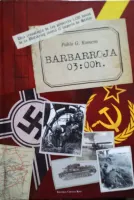[English version at the end]
Los Mitos de Barbarroja (II)

La propaganda de guerra en forma de literatura, cine y otros medios publicada en los años del conflicto 1939-45 y todas las miles de obras de rigor escritas, pero sin el contrapunto de aquellas publicadas tras el Telón de Acero, han calado de tal forma en Occidente que han desvirtuado la importancia la Operación Barbarroja y de toda la posterior guerra en el este, hasta la toma de Berlin por los soviéticos Zhukov y Koniev en mayo de 1945. La imagen de tal hecho de armas ha quedado sumida en una especie de campaña cruel y exótica, pero de consecuencias menores en el devenir de la Segunda Guerra Mundial en Europa. Esta imagen es tan incorrecta como injusta.
En el mundo actual donde el constante bombardeo informativo crea corrientes de pensamiento parciales (con intención y sin ella), reconocemos a los aliados occidentales (principalmente los EE.UU. y Gran Bretaña) como los actores principales de la derrota de Adolf Hitler y su régimen nacional-socialista. Pero si profundizamos y vamos más allá de los atractivos de la historia “hollywoodiense”, hallamos otros datos y cifras aplastantes. La Segunda Guerra Mundial le costó a los EE.UU. (en todos los teatros de operaciones) medio millón de hombres. Los soviéticos perdieron una cifra tan astronómica como difícil de imaginar y calcular. Sobrepasa los 20 millones.
Es en los campos de batalla de la Europa oriental, desde las puertas de Moscú, las montañas del Cáucaso y las aguas del caudaloso Volga (Stalingrado) hasta las calles de Berlín donde la Segunda Guerra Mundial se resolvió en Europa. Y este hecho, iniciado con la operación de invasión del 22 de junio de 1941 (Operación Barbarroja), cambió para siempre la historia del viejo continente y por consiguiente del mundo entero. Las estructuras en las que apoyamos nuestra actual civilización nacen de aquellos resultados.

Comienza en marzo de 1941. Un total de 50.100 millones de dólares es el monto de los suministros que se entregarán: 31.400 millones a Gran Bretaña, 11.300 millones a la URSS, 3.200 millones a Francia y 1.600 millones a China.
El lector podría preguntarse a la luz de estos párrafos “¿La entrada entonces de los EE.UU. en el conflicto no fue determinante?” (recordemos que no fue hasta diciembre de 1941 cuando el coloso americano entró en la guerra). O preguntado de otro modo “¿Stalin se las hubiera bastado para derrotar a Hitler en solitario?”. Contestar a esto entra dentro de la historia-ficción, pero lo que es indudable es que el desarrollo de la batalla hubiera sido distinto (y nuestro actual mundo). Dejémoslo ahí.
¡Ya a la venta Barbarroja 03:00 hrs!
¿Te ha resultado de interés este artículo? ¿Querrías conocer los detalles de esta y las demás operaciones?
¡Adquiere la obra cronológica Barbarroja 03:00h en edición de coleccionista!

Deja tu comentario abajo y sigue CONQUISTAR RUSIA punteando en la opción «SEGUIR / FOLLOW» a la izquierda de la página
[English version]
Myths of Barbarossa
Second myth: The exotic Russian front
The war propaganda as literature, motion pictures or as many other means during the years of the 1939-45 conflict and the tons of rigorous works, however written without the counterbalance of those published behind the «Iron Curtain», have modelled the Western opinion about this issue. These books have biased the conception of the importance of Operation Barbarossa and the rest of the Eastern Front combat until the seizing of Berlin in May, 1945, by Zhukov and Koniev. The image of such a feat of arms has been rendered to an exotic and cruel campaing, but minor in the aftermath of World War II in Europe. This image is as inaccurate as unfair.

In the present world where the relentless mass media shape our mindsets (with and without a purpose), we have accepted the Western allies (mainly the USA and Britain) as the main actors of Adolf Hitler’s defeat. But if we research deeper beyond the attractiveness of the Hollywood-made history, we find other crushing data. The USA lost in World War II around half a million men in action (in all theatres of operation). The Soviet Union lost a figure as astonishing as difficult to imagine and calculate. It exceeds 20 million.
It is in the vast Eastern European battlefields, from the gates of Moscow, the Caucasus mountains and the waters of the mighty Volga (Stalingrad) to the streets of Berlin where World War II was resolved in Europe. And this feat that commenced on the 22nd of June, 1941 (Operation Barbarossa), shaped forever the History of the Old Continent and therefore of the rest of the world. Today’s structures that support our present civilization date back from those results.

Airplanes: 12.161
Aviation fuel: 476,000 tons
Armoured vehicles: 22,800 (12,000 tanks)
Vehicles: 409.526
Submachine guns: 112.293
Explosives: 325.784 tons
Locomotives and other railstock: 13.041
The reader is possibly wondering at this stage «Wasn’t the participation of the USA in the conflict determining enough?» (let us remember that it wasn’t until December, 1941, when the American colossus joined the war). In other words «Would have managed Stalin himself to defeat Adolf Hitler?». The answer to this question belongs to history-fiction, but undoubtedly the development of the battle would have been otherwise (and our present world). Food for thought.
Did you find this article interesting? Leave your comments below and follow us clicking on «SEGUIR / FOLLOW» at the left of the page

